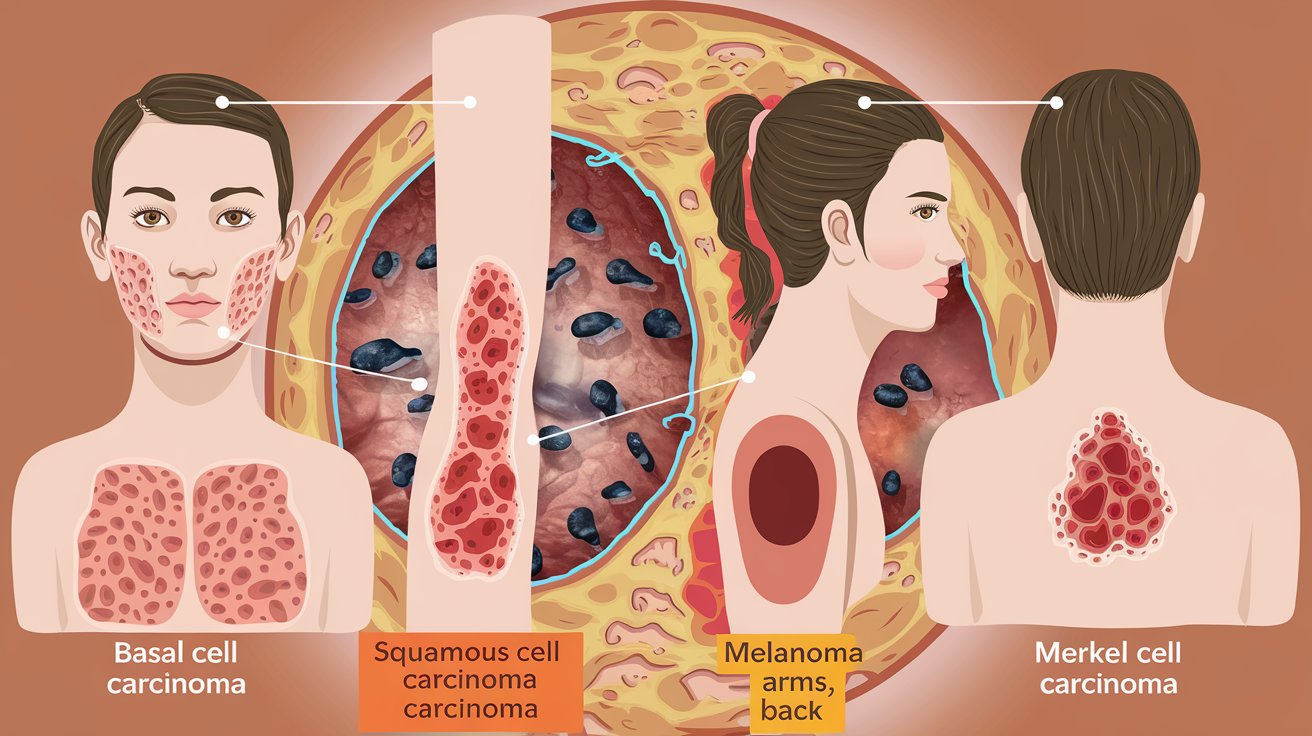Skin cancer is the most prevalent form of cancer in America, with millions of people in the country diagnosed with the disease annually. It originates through abnormal skin cell proliferation, most often caused by ultraviolet B (UVB) rays from the sun or artificial lamps. Therefore, a thorough examination of various forms of skin cancer, the causes of these cancers and ways to minimise our vulnerability to them, as well as early symptoms to look out for is important.
This blog will feature information about the different categories of skin cancer, the possible causes of the disease, and various ways of prevention that can be employed.
Types of Skin Cancer

1. Basal Cell Carcinoma (BCC)
Basal cell carcinoma or BCC is the most common form of skin cancer which contributes to approximately 80% of all skin cancers diagnosed. It starts in the basal cells which are situated at the base of the epidermis layer in the skin. BCC usually appears as a small nodule, a shiny surfaced patch or pinkish flat lesion on the parts with heavy sun exposure such as face, neck, and forearms. Though BCC does not spread to other parts of the body, it invades into the dermis if untreated and causes extensive damage to the skin.
2. Squamous Cell Carcinoma (SCC)
Squamous cell carcinoma is the second most widespread type of skin cancer that occurs in the squamous cells which form the upper layer of the skin. SCC may manifest as a firm red nodule or bump, a scaly growth or a lesion that forms an ulcer and then heals only to develop an ulcer once again. This type of cancer usually occurs in areas of skin that are frequently exposed to sun such as the face, ears, neck and the backs of the hands. Like BCC, SCC can be invasive and even metastasize to the surrounding structures, if it is not treated early enough.
3. Melanoma
Melanoma is comparatively rare than BCC and SCC but is extremely lethal in nature because it tends to metastasize to other organs and tissues. It occurs in melanocytes, which are skin cells that produce melanin the pigment that determines the color of the skin. Melanoma can begin as a new abnormal pigmented area or as a change in a pre-existing mole. The ABCDE method, (Asymmetry, Border irregularity, Color variation, Diameter larger than 6mm, Evolving size or shape) helps one to detect early signs of this type of cancer in order to get treatment at an early stage.
4. Merkel Cell Carcinoma
Merkel cell carcinoma is an incredibly rare but highly malignant skin cancer which arises from Merkel cells found in close proximity to hair follicles. This condition looks like a small, painless tumor that usually develops in areas exposed to direct sunlight and can rapidly penetrate lymph nodes and other organs.
5. Actinic Keratosis
While technically not an actual type of skin cancer, Actinic Keratosis (AK) is a precancerous skin lesion, which may develop into squamous cell carcinoma if untreated. AKs look like scaly, rough skin lesions in areas of skin exposed frequently to direct sunshine and should therefore be evaluated periodically.
Causes of Skin Cancer

The main risk factors for skin cancer include the effects of the sun and tanning beds; the dangers of ultraviolet radiation. Skin cancer is caused by the cumulative effect of UV rays to the skin, which causes changes to the DNA structure of skin cells thus causing fast and uncontrolled cell division, leading to carcinogenic developments. Other contributing factors include:
> Skin Type: Individuals suffering from prior skin conditions or those with fair skin that is prone to burning are more susceptible to it.
> Family History: One is more likely to develop skin cancer if he or she has a family history of the disease.
> Age: Skin cancer in particular is more likely to occur as one ages because of the cumulative exposure to the sun.
> Weakened Immune System: People with compromised immune systems are more vulnerable.
> Previous Skin Cancer: Skin cancer history increases the risk of developing new cancers.
Preventive Measures

1. Use Sunscreen Daily
To this effect, the use of sunscreen on the skin is one of the most efficient preventions that many people should embrace. Select a sunscreen with added UVB and UVA protection and with an SPF 30 and above and make sure to use it liberally. Specifically, sunscreen should be reapplied every two hours or when swimming or after sweating.
2. Seek Shade
Whenever you can, avoid direct sunlight especially between 10:00 am and 4:00 pm when the UV radiation is most intense. Stay indoors or, if you cannot, make certain to use umbrellas or wear appropriate protective clothing.
3. Wear Protective Clothing
Wear long-sleeved shirts and gloves, broad-brimmed hats and wraparound sunglasses when in the sun. Clothing that has been crafted to meet specific UPF (Ultraviolet Protection Factor) can also afford more protection.
4. Avoid Tanning Beds
Tanning beds use ultraviolet light that causes the skin to produce melanin and that exposes the consumer to high risks of developing skin cancer. One of the most effective things possible is to never use these devices in the first place.
5. Regular Skin Checks
It is also self-attainable to perform skin self-examinations now and then in a bid to find out whether there are new marks on the skin or whether there are moles or skin spots that were hitherto unnoticed. Any black or brown growth that is asymmetrical, with irregular edges, has more than one color, is bigger than pencil eraser or has changed in size or shape is cause for concern.
6. Annual Dermatologist Visits
It is recommended to get checked by a dermatologist and have skin examinations routinely; at least once a year. If any suspicious spots are detected then an early diagnosis is very important when it comes to treatment.
7. Educate Yourself and Others
Be aware of the skin cancer risks and protective measures by periodically revisiting reputable sources and introducing the topic to friends and family for further precaution.
Also read: Breast Cancer: Causes, Symptoms, Treatment and Prevention and Blood Cancer - Types, Causes, Symptoms, Treatment & Prevention
Conclusion
It is important for any person to know the basic information about skin cancer: the types thereof, the reasons for the cancer appearance, and the ways that would help prevent that. You can thereby reduce your risk of developing this potentially life threatening disease if you keep these proactive measures in check such as sunscreen your skin daily, avoid tanning beds and sun exposure during certain time of the day, dress in protective clothing, examine your skin on a regular basis and visit a dermatologist once a year.
Always bear in mind that early stage treatment is more effective; it is important to be vigilant about any changes to your skin to ensure that you remain healthy. Choosing to protect your skin, being attentive to your skincare routine, and taking care of yourself can help you have great skin and lower your chances of skin cancer.
